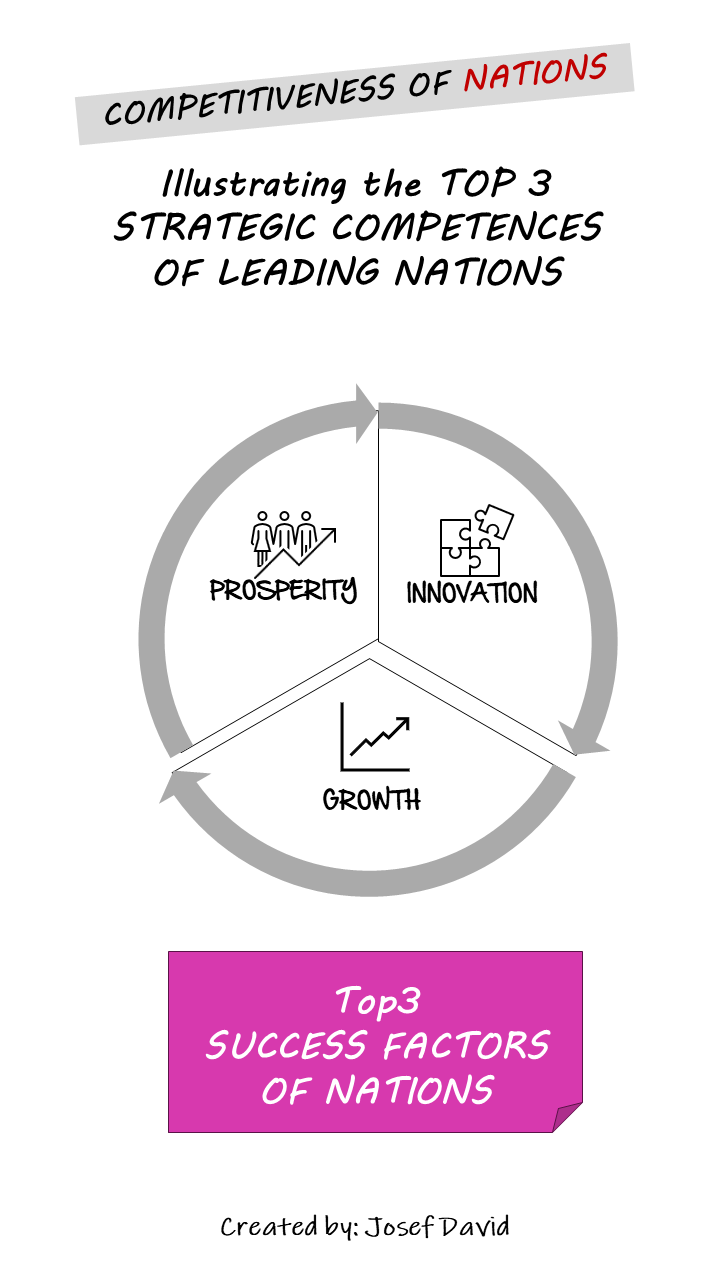Introduction
The world is a global village, and nations are in constant competition with each other to achieve economic, technological, and social supremacy. This competition is not just about military might or geographical size; it’s about the ability to innovate, adapt, and thrive in an ever-changing global landscape. In this context, let’s delve into the 10 Most Competitive Nations (MCNs) in the world as of 2024, their success factors, and how Austria fits into this global picture.
WHO are the 10 MCNs in the World 2023?
Source: Word Competiotiveness Center
According to the Global Competitiveness Report 2023, the top ten most competitive nations are:
| 2023 | Country | 2022 | Ranking Change | |
| 01 | Denmark | 01 | – | |
| 02 | Ireland | 11 | +9 | ↑ |
| 03 | Switzerland | 02 | -1 | ↓ |
| 04 | Singapore | 03 | -1 | ↓ |
| 05 | Netherlands | 06 | +1 | ↑ |
| 06 | Taiwan, China | 07 | +1 | ↑ |
| 07 | Hong Kong SAR | 05 | -2 | ↓ |
| 08 | Sweden | 04 | -4 | ↓ |
| 09 | USA | 10 | +1 | ↑ |
| 10 | UAE | 12 | +2 | ↑ |
These nations have consistently demonstrated their ability to harness resources and drive growth.
WHY are they leading the pack?
These countries lead the pack due to a combination of factors including :
Robust infrastructure, efficient governance systems, advanced technology adoption, high-quality education systems and a conducive environment for business operations. They have managed to create an ecosystem that fosters innovation and encourages entrepreneurial activities.
WHAT are their 10 common success factors?
1. Strong Institutions: These countries have strong political institutions that ensure stability and rule of law.
2. Infrastructure: They have invested heavily in infrastructure which facilitates trade and commerce.
3. Macroeconomic Stability: These nations have stable economies with low inflation rates and steady growth.
4. Health and Primary Education: They prioritize health care and primary education which results in a healthy and educated workforce.
5. Higher Education & Training: They also invest in higher education and vocational training to equip their citizens with advanced skills.
6. Goods Market Efficiency: These countries have efficient goods markets characterized by free trade policies.
7. Labor Market Efficiency: Their labor markets are flexible yet protected ensuring worker rights while promoting efficiency.
8. Financial Market Development: They have well-developed financial markets that provide the necessary capital for business growth.
9. Technological Readiness: These nations are quick to adopt and implement new technologies.
10. Market Size: These countries have large domestic or international markets that businesses can tap into.
Austria’s competitive rank in 2024? Austria’s strength and weakness
In 2023, Austria ranks 24th in the Global Competitiveness Index. Austria lost Competitiveness during the last years of the ÖVP / Green Government. Austria’s Ranking Change – 4 versus 2022
Austria’s strengths lie in its robust infrastructure, high-quality education system, and strong institutions. The country also boasts a high standard of living and a well-developed social security system.
However, Austria faces challenges in terms of labor market efficiency and technological readiness. The country has rigid labor laws that can hinder business flexibility, and it lags behind in terms of adopting new technologies compared to the top ten competitive nations.
Conclusion
In conclusion, competitiveness among nations is a complex interplay of various factors ranging from infrastructure to education to technological readiness. The top ten most competitive nations have managed to create an environment that fosters growth, innovation, and prosperity. While Austria may not be in the top ten, it still holds a respectable position with its own set of strengths and areas for improvement. As the world continues to evolve, it will be interesting to see how these rankings change and which countries will rise to the challenge of global competitiveness.
